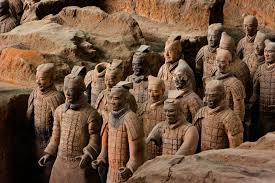
What Else Was Found in the Terracotta Army Pit Besides Soldiers?
The Terracotta Army is one of the most iconic archaeological discoveries of all time. The army of life-size terracotta figures was buried with Qin Shi Huang, the first emperor of China, in 210–209 BC. The figures were meant to protect the emperor in his afterlife.
Beyond the Soldiers: A Glimpse into the Emperor's Afterlife
While the sheer number of soldiers (estimated to be around 8,000) is impressive, the pits also contained a wealth of other artifacts that provide valuable insight into the life and times of Emperor Qin Shi Huang and the practices of the Qin dynasty. Here are some of the significant finds:
1. Horses and Chariots: Instruments of Power and Prestige
Hundreds of terracotta horses, intricately detailed and often depicted in dynamic poses, have been excavated from the pits. These equine figures, along with bronze chariots, showcase the high regard for horses in warfare and as status symbols during the Qin dynasty. The chariots, often elaborate in their construction and decoration, offer glimpses into ancient Chinese craftsmanship and military technology.
2. Bronze Ritual Vessels: Symbols of Authority and Sacred Rites
The pits yielded a significant collection of bronze ritual vessels, some of which are considered masterpieces of ancient Chinese metallurgy. These vessels, often adorned with intricate designs and inscriptions, were used in religious ceremonies and ancestral worship. Their presence underlines the importance of ritual and the emperor's role as both a secular and spiritual leader.
3. Jade Jewelry and Ornaments: Markers of Status and Beliefs
Jade held immense cultural and religious significance in ancient China. The discovery of jade jewelry and ornaments within the pits, including pendants, beads, and belt ornaments, signifies their value as status symbols and their association with good fortune and protection. These artifacts offer insights into the social hierarchy and belief system of the Qin court.
4. Gold and Silver Ornaments: Expressions of Wealth and Power
The presence of gold and silver ornaments further emphasizes the opulence and grandeur associated with Emperor Qin Shi Huang. These artifacts, which include rings, earrings, and belt plaques, reflect the emperor's vast wealth and his desire to carry his earthly splendor into the afterlife. They also shed light on the craftsmanship and artistic styles prevalent during the Qin dynasty.
Sima Qian's Account: Suppressing the Secrets of the Tomb
The historian Sima Qian, writing a century after the tomb's construction, noted the emperor's apprehension about his artisans revealing the treasures within. He wrote that Qin Shi Huang feared they "might disclose all the treasure that was in the tomb," suggesting that the discovered artifacts may represent only a fraction of the riches originally buried. This statement fuels further speculation and fascination surrounding the tomb's contents, much of which remains unexcavated.
FAQs
1. Why were these artifacts buried with the Terracotta Army?
These items were believed to be necessary for the emperor's comfort, entertainment, and status in the afterlife. They reflect the belief system of the time, where death was seen as a continuation of earthly life.
2. Are there any plans to excavate the entire tomb?
While the potential for further discoveries is immense, there are currently no plans for a full excavation. Concerns about preserving the fragile artifacts and the potential for triggering ancient booby traps remain significant.
3. What can these artifacts tell us about the Qin Dynasty?
These artifacts offer a glimpse into the Qin Dynasty's artistry, technological advancements, religious practices, social structure, and the emperor's power and influence. They paint a vivid picture of a sophisticated and powerful civilization that shaped the course of Chinese history.